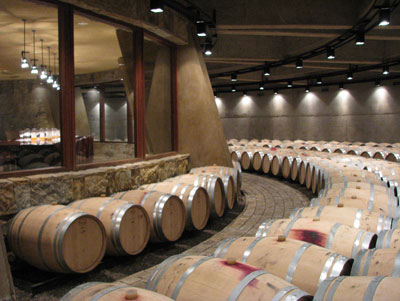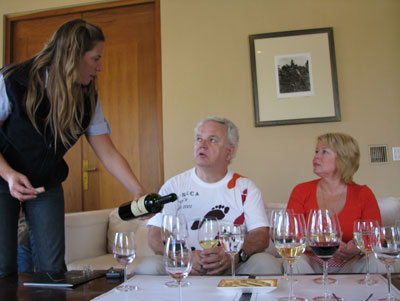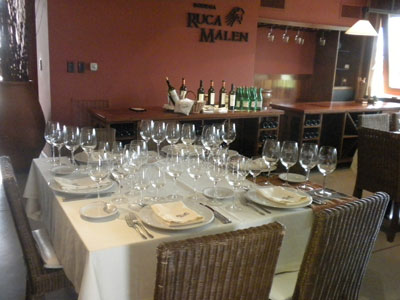Touring and tasting in Argentina’s Mendoza wine region
by George & Elena Vander Voort, Wadsworth, IL
Argentine wines have improved dramatically over the past 15 years, moving from predominantly cheap, rustic vino de mesa (wine of the table) to world-class quality. In the late 19th century there were only about 6,000 hectares, or 14,830 acres, of wine vineyards in Argentina. Today there are about 208,000 hectares of wine grapes in over 26,000 vineyards, with about 900 actual wine producers.
The principal wine-producing bodegas are in the Luján de Cuyo region, just south of Mendoza City, although a number of superb bodegas have been established at higher elevations a bit farther south in the Valle de Uco.
My wife, Elena, and I traveled there in February ’10.
Area wines
Despite Argentina’s long history of wine making, few outsiders had any experience with Argentine wines until the late 1990s. Virtually all of the country’s vast production was consumed by its populace (90 liters per day). But since the push to upgrade wine quality began, led by the well-known Nicolás Catena (“the Robert Mondavi of Argentina”), many of us have tasted their wines, chiefly Malbec or blends of Malbec with Cabernet Sauvignon and/or Merlot. Argentine malbec wines do not exhibit harsh tannins and are very food friendly.
Argentine whites include Torrontés, a relative of Muscat or Muscadet, which is unique to Argentina. The best Torrontés grapes come from Cafayate, in the Salta region, and from the northern end of the Mendoza region, at altitudes approaching 2,000 meters.
Taste is very subjective, and what turns one person on may turn another off — there are no absolutes in tasting wine. But most people usually can agree if a wine is very good, good, mediocre or poor.
To really enjoy a bottle of wine and get a full appreciation of it, I recommend that you read some of the better wine books about how to taste wine, unless you are already quite experienced. “Wine for Dummies” has a really nice discussion on wine tasting.
Getting there
Our winery trip got off to a rocky start. One of the four in our group was snowed in and didn’t make the trip, and the flight from Chicago to Washington Dulles that my wife and I booked was canceled twice due to an impending storm, but we finally left Chicago on one of the last flights out before the storm hit hard.
Several airlines fly from the US to Buenos Aires or to Santiago, Chile, which is actually much closer to Mendoza City.
We flew into the (Ezeiza) Ministro Pistarini International Airport (EZE), which is a good distance outside of Buenos Aires. We had contracted Alehandro Ihsua of Orvitur Transfer Services (Buenos Aires, Argentina; phone +54 11 5217 3357 or e-mail incoming@orvitur.com) to meet us and take us to the Jorge Newbery domestic airport (AEP), on the edge of the city, to catch our one-hour flight to Mendoza’s El Plumerillo Airport (MDZ).
Argentina has started charging Americans a reciprocity fee of $131, good for 10 years, which you must pay (cash or credit card) before going through Customs at Ezeiza.
The other member of our group was Dr. Tatiana Navrotskaya from St. Petersburg, Russia, who made it to Argentina several days ahead of us.
Fodor’s “Argentina” guidebook (fifth edition, 2008) lists eight hotels in Mendoza City, and there are at least a dozen wine lodges between Mendoza City and the Valle de Uco.
We chose to rent a two-bedroom apartment at San Suites Mitre (Av. Mitre 753; phone/fax +54 261 4413500, www.sansuites.com.ar), about three blocks from Plaza Independencia, as this was a less expensive option. We paid 50% down ($610 by PayPal) and the balance in cash upon arrival for our nine-night stay. We also paid a cash security deposit of $200, which we got back before checking out. However, when we arrived, our two-bedroom apartment had been given to a family, so were were given two one-bedroom apartments — a more expensive option — for the same price.
Located in a 15-floor building, the apartments were clean and nicely furnished. Units with one, two or three bedrooms are available, each with one or more bathrooms and a kitchen but minimal pots and pans. The building has an outside pool, a restaurant that serves breakfast (price not included) and air-conditioning.
February in Argentina is like August at home, and the temperature was in the 80s every day. One day was overcast and we actually saw a few sprinkles of rain that day.
Getting around
Wineries require that visitors make reservations at least 24 hours in advance; I started sending e-mails to wineries more than a month before our trip. A few responded on the first try, some on the second, some on the third, some on the fourth and some on the fifth try. Two, Rutini Wines in Maipú and Achaval Ferrer in Perdriel, did not respond even after five e-mails! You can also have your hotel staff call a day in advance to make reservations for you.
We had decided to rent a car, but, as my missing buddy was to navigate, that became impossible, especially at night. Fodor’s does not recommend renting a car — and we found out why! The roads are not in great physical shape, and finding places (I couldn't find a GPS map of the area for my Garmin system, unfortunately) can be quite challenging, as many wineries have no signs along the roads telling where to turn and, once you leave Mendoza City, finding a street sign at all is nigh unto impossible!
If you are not on an organized tour, you have two options for getting around. For one day we tried a remise, basically a fancy taxi, from Remises Aeropuerto Mendoza (phone 0261 448 1122). The daily cost was around $150 with an English-speaking driver and $115 with a non-English-speaking driver. (The cost is higher if you drive quite far south to the Valle de Uco.)
The next day we decided to take a taxi to our first winery. After the tasting, we had the winery call a taxi to take us to the second winery. That ended up being much less expensive than the remise.
Luckily, our second taxi driver, Luis Texcira (phone 155 277 212), turned out to be a very nice man who spoke some English and knew his way around, and he was a fun guy. We used him for the rest of our daily trips.
Depending on how far south we went, our daily cost with Luis ran from about $80 to $180 (the latter for an excursion to the Valle de Uco, returning to Mendoza at about 8 p.m.).
Winery visits
In general, we scheduled two winery visits per day and had a tasting lunch at one, usually around 1 p.m. (most stop serving guests at about 3:00). On our first day, we visited only one winery, Kaiken Wines (www.kaikenwines.com) in Luján de Cuyo. We had had their wines in the US and were very impressed by them, even though Kaiken is not one of the big-name bodegas.
Most evenings, we had a wine-and-cheese party in our apartment, picking up goodies at the local Carrefour grocery store or at Mendoza’s Mercado Central. Several wineries make olive oil, as in Italy, Greece and Spain, and we could also get a variety of cheeses and sausages.
The local supermarket breads were disappointing compared to those of France and Italy, but the sparkling wines were delightful, and we downed quite a few during our evening wine parties.
Our second winery was Mendel (phone +54 261 5241621, www.mendel.com.ar), also a lesser-known winery and also in Luján de Cuyo. Without a local driver, you will never find this winery!
From there we went to the Valle de Uco to visit Andeluna Cellars (phone +54 2622 423226, www.andeluna.com), started by H. Ward Lay (son of the Frito-Lay founder) in 2003. Here we had chef Pablo del Rio’s six-course tasting menu with five wines — one of the best meals we had. We were blown away by the quality of the cuisine.
My wife and I have eaten at more than a dozen three-Michelin-star restaurants in France and two in San Sebastián, Spain, so we are familiar with good cuisine when we taste it, but this meal came without the three-star price — and wine was included! The meal cost 245 pesos ($65) each.
The US buck goes pretty far in Argentina, so if you have painfully managed to endure euro-to-dollar exchange rates of up to 1.65, you and your bank account will be happy there.
We also visited Trapiche (phone +54 261 52076666, www.trapiche.com.ar), a very large winery with its origins in the late 19th century. Their wines are readily available in the US and are outstanding, covering a wide range of grapes.
This was followed by lunch at Club Tapiz (phone +54 261 496 3433,www.club-tapiz.com.ar), a three-course meal with six choices of appetizers, six choices for the main course and five selections for dessert, each with a recommended wine, all for 152 pesos ($40) per person. In addition to their restaurant, Club Tapiz has seven rooms and a spa, and you can have a gaucho take you on a carriage ride through their vineyards.
Also notable is Dominio del Plata (phone +54 261 498 9200, www.dominiodelplata.com.ar) in Agrelo, opened by Susana Balbo and Pedro Marchevsky in 1999. Susana is one of Argentina’s most famous wine makers and is largely responsible for crafting Torrontés wines to a super-star quality. If you have not tried this white wine, get some!
Our last day of touring the wineries began at the spectacular winery of O. Fournier (phone +54 2622 451579, www.ofournier.com), located in the foothills of the Andes at La Consulta in the Valle de Uco. The Spanish family Ortega Gil-Fournier bought 286 hectacres of land there and constructed an ultramodern winery with a visitors’ center and restaurant, Urban — another outstanding culinary treat! Our four-course meal there was accompanied by four wines for about 107 pesos ($28) per person.
Our final winery visit was at Bodegas Salentein (phone +54 2622 429000, www.bodegasalentein.com) at Los Arboles in Tunuyán, also in the Valle de Uco. It, too, was quite modern, with a spectacular aging cellar in the shape of a cross — a veritable cathedral of wine! Their wines were first class and the setting was lovely.
Although we ate big lunches at the wineries and had evening wine-and-cheese parties in our rooms, we did manage to try a few restaurants in Mendoza.
1884 Restaurante Francis Mallmann (Belgrano 1188), just south of the city in Godoy Cruz, is a “must visit” for all foodies. We also ate at La Florencia (Sarmiento 698), with great Italian food and a vast wine list, and Azafrán (Sarmiento 765), a combination restaurant, wine store and gourmet grocery.
Planning your trip
Fodor’s guidebook is by far the most detailed regarding the Mendoza area, with about 62 pages of coverage. There are also several useful websites to help in planning a visit, including www.vinesofmendoza.
com, www.winesofargentina.org, www.argentinawineguide.com, www.welcomeargentina.com, www.argentinawinehotels.com and www.turismo.mendoza.gov.ar.
The Vines of Mendoza (567 Espejo) is a relatively new wine bar and vinoteca located just off Mendoza City’s Plaza Independencia, around the corner from the lovely Park Hyatt hotel. It was started by two American wine lovers who met in Mendoza and decided to dump their former careers and move to the city. It is open daily (3-10 p.m.) and they hold tastings.
We went to two tastings there, the second with wines by Bodega del Fin del Mundo (Winery at the End of the World) in Patagonia.
The Vines of Mendoza also organizes tours, has an export wine club and provides information on bodega visits. On their brochure, they recommend visiting only three to four bodegas per day. If you try that (and I can’t see how anyone could possibly do more), have a nondrinking driver!
From the standpoint of books, Alan Young’s “Wine Routes of Argentina” is getting a bit dated due to the vast amount of new winery construction since 1998, when the book was published. “Wines of Argentina,” by wine consultant Michel Rolland and Argentine journalist Enrique Chrabolowsky, has details on 117 Mendoza wineries. It is available in English, Spanish and Portuguese.
Summing up
We have visited many wine areas all over the world, even some in unlikely places such as India. Mendoza is unique in that the area, which has been growing grapes and making wine commercially for more than 100 years, was isolated and did not attract travelers or development until the mid to late 1990s.
As a rural area, sparsely settled, it had no facilities for visitors, so the major wineries stepped in and built their own restaurants and some small hotels. No other wine region is set up this way, and we found it delightful.
The major negative issue is finding your way to the wineries. Some are easy to find but others are nearly impossible. Even our local driver had problems finding one winery.
If visiting Argentina, don’t miss spending a few days in Buenos Aires. If you’ve never been there, it’s a wonderful, scenic city. I highly recommend going to at least one tango show. Sure they are a bit touristy, but the music and dancing are super. It’s a great way to begin and end your trip.






